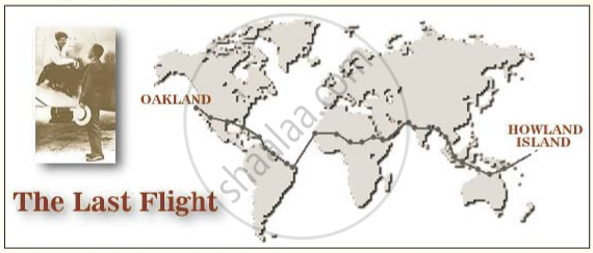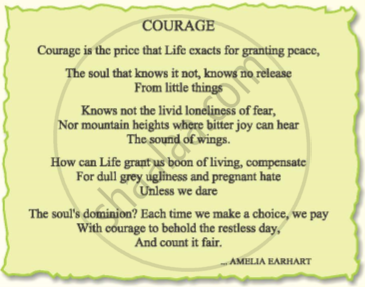Advertisements
Advertisements
Question
What are the precious things mentioned in the story? Why are they precious?
Solution
There are two precious things in the story: the Prince’s leaden heart and the dead swallow.
They were both precious because they were kind and selfless. The Prince was sad as he saw so many people suffering in his city. He gave away his ruby, sapphires and all his gold to them. He did not think about himself for once. He was more concerned about the well-being of his people even though he was dead.
The little swallow was precious because it showed kindness by carrying the Prince’s messages to the poor and deciding to stay back for the Prince when he was blind, though he knew that he would face difficulties in winter, which was fast approaching. It actively participated in helping the poor and needy in the city. The swallow was so precious that when it died and fell down at the Prince’s feet, the Prince’s leaden heart broke into two.
When God asked one of his angels to bring him the two most precious things in the city, the angel brought him the leaden heart and the dead bird. God said that the little bird would forever sing in His garden of Paradise and the Happy Prince would praise Him in His city of gold.
APPEARS IN
RELATED QUESTIONS
Think about the Text
Discuss in pairs and answer question below in a short paragraph (30 − 40 words).
“I looked into the mirror and smiled,” says the doctor. A little later he says, “I forgot my danger and smiled feebly at myself.” What is the doctor’s opinion about himself when:
(i) he first smiles, and
(ii) he smiles again? In what way do his thoughts change in between, and why?
The world's most famous female aviator, Amelia Earhart, disappeared in 1937, as she attempted to become the first woman to fly around the world with her navigator, Fred Noonan. She was last heard when she was around 100 miles from the tiny Pacific Howland Island on July 2, 1937.
Read the story of her 'Final Flight'.
On June 1, 1937 Amelia and her navigator Fred Noonan departed from Miami, Florida; bound for California. Their first destination was San Juan, Puerto Rico; from there, skirting the northeast edge of South America; and then on to Africa and the Red Sea.
The flight to Karachi was another first. No one had previously flown non-stop from the Red Sea to India before. From Karachi, the Electra flew to Calcutta on June 17 from there on, to Rangoon, Bangkok, Singapore and Bandoeng.
The monsoon prevented departure from Bandoeng for several days. Repairs were made on some of the 'long distance' instruments which had given trouble previously. During this time, Amelia became ill, and suffered from dysentery that lasted several days.
It was June 27 before Amelia and Noonan were able to leave Bandoeng for Port Darwin, Australia. At Darwin, the direction finder was repaired, and the parachutes were packed and shipped home as they would be of no value over the Pacific .
Amelia reached Lae in New Guinea on June 29. At this point they had flown 22,000 miles and there were 7,000 more to go over the Pacific. Amelia cabled her last commissioned article to the Herald Tribune. Photos show her looking very tired and ill during her time at Lac.
The U.S. Coast Guard cutter, Itasca had been standing off Howland Island for some day to act as a radio contact for Amelia Radio communications in the area were very poor as Itasca was overwhelmed with commercial radio traffic that the flight had generated .

Amelie left Lae at preciaely 00:00 hours Greenwich Mean Time on July 2 . It is believed that the Electra was loaded with 1,000 gallons of fuel , allowing for 20-21 hours of flying .
At 07:20 hours GMT Amelia provided a position report placing the Electra on course as some 20 miles southwest of the Nukumanu Islands . The last weather report Amelia was known to have received was before take-off . The head wind speed had increased by 10-12 mph, but it is not known if she ever received the report.
At 08:00 GMT Amelia made her last radio contact with Lae . she reported being on course for Howland Island at 12,000 feet . There is no real evidence as to the precise track of the aircraft after Nukumanu . No one saw or heard the plane fly over .
Several short transmissions were received by the Itasca with varying signal strengths but they were unable to get a fix on her location because they were too brief. At 19:30 GMT the following transmission was received from the Electra at maximum strength.
"KHAQQ calling Itasca. We must be on you but cannot see you ... gas is running low ... "
At 20: 14 GMT, the Itasca received the last voice transmission from Amelia giving positioning data. The Itasca continued to transmit on all frequencies until 21:30 hours GMT. They determined that Amelia must have died at sea and began to implement search procedures.
It has been determined that the plane went down some 35-100 miles off the coast of Howland Island. A life raft was stowed on board but no trace was ever found of the raft. Some experts felt that the empty fuel tanks could keep the plane afloat for a period of time.
President Roosevelt authorized a search party of 9 naval ships and 66 aircrafts at an estimated cost of over $4 million. On July 18, the search was abandoned by ships in the Howland area. George continued to seek help in the search, but by October he too abandoned all hope of finding them alive.
Amelia had been sending letters to George at stopovers all along her route quite regularly. These were published in the book 'Last Flight'. The book has a note from her to George ....
"Please know I am quite aware of the hazards ... I want to do it because I want to do it. Women must try to do things as men have tried. If they fail, their failure must be, but a challenge to others. "

Amelia created a number of aviation records :
o The first woman to fly across the Atlantic in 1928
o The second person to fly solo across the Atlantic in 1932
o The first person to fly solo from Hawaii to California in 1935 Guided by her publicist and husband, George Putnam, she made headlines in an era when aviation had gripped the public's imagination.
Listen to an interview between a radio jockey and a pilot.
"They say it was a shocking sight
After the field was won;
For many thousand bodies here
Lay rotting in the sun;
But things like that, you know, must be
After a famous victory.
"Great praise the Duke of Marlbro'won,
And our good Prince Eugene."
"Why,'twas a very wicked thing!"
Said little Wilhelmine.
"Nay...nay...my little girl,"quoth he,
"It was a famous victory.
"And everybody praised the Duke
Who this great fight did win."
"But what good came of it at last?"
Quoth little Peterkin.
"Why that I cannot tell,"said he,
"But 'twas a famous victory."
Read the lines given above and answer the question that follow.
How does the poet describe the scene on the field after the battle?
What does the poet mean when lie compares the world to a battlefield? What should our role be in this battle?
Explain with an example how can you put out fire by cutting the supply of oxygen.
What did the narrator do with the hatchet?
How did the bear grow up a vegetarian?
Narrate the tale of two birds in your own words.
Why are snakes dangerous, according to you?
Make noun from the word given below by adding –ness, ity, ty or y
Creative___________.
This story has a lot of rhyming words, as a poem does. Can you write out some parts of it like a poem, so that the rhymes come at the end of separate lines?
For example:
Patrick never did homework. “Too boring,” he said. He played baseball and hockey and Nintendo instead.
Multiple Choice Question:
What happens to the kite all of a sudden?
Multiple Choice Question:
How can a singer create beauty?
Answer the following question.
What was the ‘game’ that every child in the school had to play?
What information about snakes do you get in the lesson Desert Animals?
Answer the following question:
Why was Rasheed upset?
Who was the bearded man?
Study the following phrases and their meanings. Use them appropriately to complete the sentences that follow.
I promise to ………….. on your brother when I visit Lucknow next.
Complete the following sentence by providing a reason.
Beethoven amputated the legs of his piano because ______.
